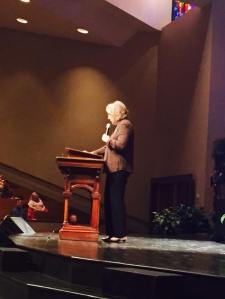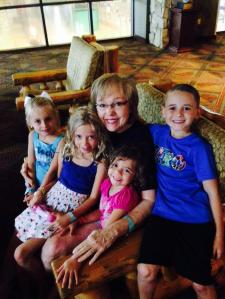Last night, a few parents of preschoolers gathered together at First Baptist Richardson to talk about spiritual disciplines as foundations for spiritual formation with our kids. I had the opportunity to share some thoughts, though it, of course, was very much a group effort. Here are some key reflections and practical ideas from our discussion last night.
To take an active role in positively forming your kids to know and follow Jesus, it starts with you, the parents. Far more than any times of prayer or family worship, your children will be shaped by who you are. So take seriously your own spiritual development and growth. Our emphasis last night was on the spiritual disciplines, which I defined as “things we do to be with God.” As parents, it’s important that you first familiarize yourselves with the various spiritual disciplines. I can’t more highly recommend that you read Richard Foster’s Celebration of Discipline. It’s a book I return to about every other year or so.
We talked about viewing the spiritual disciplines as rhythms, just like breathing. If you only inhaled, you would die. If you only exhaled, you would die. We need the rhythm of breathing in and breathing out to live. It’s similar in the Christian spiritual journey. We need to practice things that set us up to receive from God and things that push us out into the world to pour out what we have received from God.
Once you have a decent grasp on the spiritual disciplines, consider crafting a rule of life for yourself that you might share with your spouse or your Life Group/Bible Fellowship. If you decide to follow a rule of life, know that it’s good to revisit it and adjust as needed. There is also the option of meeting with a spiritual director, someone who is trained and experienced in the Christian spiritual journey—someone who’s perhaps further down the path than you—who can speak in to your life and serve as a guide in your journey.
We then talked about some practical things you can do with your kids to invite them to be with God.
For prayer, we talked about encouraging short times of silence. I like to set a timer that gives some structure to the silence. With preschoolers, start with a minute. You may not get to two minutes until they’re teenagers, but even a minute of silence exposes them to listening prayer. Be sure, of course, that you emphasize that the silence is for the purpose of being with God. I also like short, responsive prayers with my little kids. I’ll put a few that I’ve written below. I like the idea of a sacred space in the home, if you can create one. For kids, I’d encourage you to include other elements besides chairs and a Bible. Consider using a candle or a bell to create a frame around the time of prayer. Maybe have paper with crayons or paints available for your children to create something as their prayer to God.
In addition to getting a good age-appropriate Bible, consider learning Bible stories really well yourself and telling them to your kids without anything in between you and your child: just pure storytelling. Speak slowly and help them experience the stories. At the end of the story, I recommend using “I wonder” statements (For example, “I wonder what Mary was thinking when the angel told her she was going to have a baby.”). This invites some participation from our kids, encourages them to use their imaginations, and places them in the stories themselves. But it also doesn’t demand an answer. It’s not about being right or wrong about the facts of the story. It’s giving them space to wander around inside the story and get to know it well. (This is very closely related to the classic practice of lectio divina—spiritual reading—in which you read the story from the Bible contemplatively. Here is a pretty straightforward primer on lectio, though there are lots of resources out there.)
The church calendar can also be a very helpful tool as you journey with your kids. Advent, Christmas, Epiphany, Lent, Easter, and Pentecost are the six major seasons of the church year. Each one is a journey of varying length with its own focus and direction. It can add some variance to your prayer time together.
Also consider intentional ways you can serve the world with your kids. Here are just a few practical ideas.
- Get to know your neighbors and intentionally reach out to them: make them cookies together, have the kids write them notes, maybe even go over and visit them in person just to see how they’re doing.
- If a friend at school or church is in the hospital, make something for her and go visit her.
- Fill a brown paper bag with non-perishable foods, bottled water, travel toothpaste/toothbrush; have your child decorate the outside of the paper bag; keep it in the car for when you encounter someone asking for money on the side of the road.
- Help your child pick out one of their own toys (maybe several toys) to donate to Toys for Tots or Goodwill (both accept used toys).
- If there are projects your kids like to help you with (yard work, gardening, cooking, cleaning, wood working, etc.), consider finding an outlet for those projects other than your own home: maybe an older neighbor or a different part of town; for example, if you like to garden together, maybe visit a nursing home or a school and see if they’ll let you plant a flower garden somewhere for the residents/students.
Prayers
- Advent: “Dear Jesus, we wait for you to come. Come, Lord Jesus.”
- Christmas: “Dear Jesus, thank you for coming. Come again, Lord, Jesus.”
- Epiphany: “Dear Jesus, thank you for showing yourself to us. Now show yourself through us.”
- Lent: “Dear Jesus, thank you for going to the cross. Be with us as we follow you.”
- Easter: “Dear Jesus, you died for the sin of the world. You rose to give us new life.”
- Pentecost: “Dear Jesus, thank you for being with us. Help us to be with you.”
On the way: “Dear Jesus, give me your eyes…to see what you want me to see. Give me your ears…to hear what you want me to hear. Give me your heart…to love who you want me to love.”
Nighttime [from the Book of Common Prayer]: “Guide us waking, dear Lord and guard us sleeping. That awake we may watch with Christ, and asleep we may rest in peace.” [This one I used to pray every night by myself as the very last word said before I left their room. Now, they like to do it responsively, because they’ve learned it.]
Candle-Lighting Prayer (at the beginning of a time of family worship or prayer): “We light a candle in the name of the Father who gives life, in the name of the Son who loves life, and in the name of the Spirit who is the fire of life.”[i]
A nice song of blessing (based on Num 6:24-26, sung to the tune of “Edelweiss”). I sing this as a kind of lullabye-blessing to my kids in bed.[ii]
May the Lord, mighty Lord, bless and keep you forever.
Granting peace, perfect peace, courage in every endeavor.
Lift your eyes and see his face, know his grace forever.
May the Lord, mighty Lord, bless and keep you forever.
Consider writing your own blessings for your children: maybe a blessing for any time you part and a blessing for nighttime. Make your blessings short but meaningful. These are the words you want to leave with them. Start with “May you…”
Resources
I have scores of books on spiritual formation, books on spiritual practices/disciplines, prayer books, etc. Here are four that are fine places to start.
Richard Foster, Celebration of Discipline
The (modern) classic book on the Christian spiritual disciplines.
Valerie E. Hess and Marti Watson Garlett, Habits of a Child’s Heart
This is a kind of Celebration of Discipline written for parents. It’s wonderfully practical and instructive. Our church is buying copies of this book for the parents who were in attendance last night.
Ruth Haley Barton, Sacred Rhythms
A great read on spiritual practices, with an especially helpful final chapter on developing a rule of life.
Henri Nouwen, The Way of the Heart
I recommend reading pretty much anything you can get your hands on by Nouwen. This little book deals primarily with the practices (and importance) of silence, solitude, and prayer. Really helpful!
I’d love to get feedback from you on this. If you have practices that have helped you and your young children be with God together, would you share them with me?
[i] I learned this prayer from my professor and friend Hulitt Gloer. I’m not sure if he wrote it.
[ii] I learned this song from a former church (DaySpring Baptist Church, in Waco, TX). Other congregations sing it as well as a benediction, with various lyrics. I can find nothing to indicate who first put these words to this tune.

